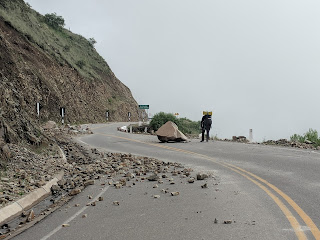Not only were Fidgit and I rejected in our attempt to cross Rio Pampas, we then had to walk along the same taunting river for a day and a half to get to the bridge crossing. Along the way, we were told about a few years ago, when the previous bridge had been washed away. As we crossed the new bridge, we could see the leftovers of the old bridge just a few meters downstream. Even more grateful to have a bridge to cross this river, we immediately began our 2,000 meter (6,500ft.) ascent out of the valley. The trend of sun and heat during our uphills continued through the afternoon, with a cooling breeze coming through just before we made our way into the small town of Chumbes. We ended up finding a small Hostel and spending the night.
The fog was thick as we made our way along the next morning, with cars honking as they sped along the two-lane highway through town. Since we weren't able to cross Rio Pampas at the base of the valley, we were using the road as our main navigation aid, following along it and cutting off the extraneous switchbacks whenever possible(which, thankfully, was often). We walked up and along the route until we came to a small town, where a local woman told us about a shortcut up to the pass we were headed to. We then followed a narrowing valley up and up. The creek became a constant as we wound up the valley, though meadows and scrub brush until we got high enough to be wading through knee-high grasses and back to the highway for the last kilometer to the top. Exhausted from a 1,500 meter climb, we set up our tents in the first safe flat spot we found and slept soundly, with a few cars passing through the night.
Waking the next day to once again being in a cloud, we packed up and followed the one and a half lane road we had turned onto the evening before. It descended from the pass and the skies cleared as the day went on. We were now meandering slowly down a long valley. We wound down and through many small towns, most of which had at least a shop, many had small restaurants as well. Not many options, but more than nothing was useful to us as we were running low on food because of a longer than planned stretch.
As we made our way through many of these small towns, we were stopped by the curious community members. They would ask all kinds of questions, beginning with the usual: "Where did you come from?", "Where are you going?", "Where are you from?", and "Why are you walking and not taking a car?" We try to keep our answers short and succinct to be able to respond to all of the questions. The people we walk past have been in the midst of their harvesting season, which has been interesting and educational to us. We now know what Quinoa looks like in plant form and all the crops they grow down here, as well as how the locals harvest them.
We followed the small road along and (mostly) down through the lengthy valley for multiple days towards Ayacucho. As we neared the city, things got busier. More people tried to stop us to talk so we had to pick and choose when we would stop. Right before dropping down to Ayacucho, we had lunch at a small restaurant where the proprietor sat down with us for a bit. She told us tales of her life and shared with us a short cut to get to the city faster. We thanked her, paid the 10 Soles for lunch and were on our way. Kindness seems to be everywhere. As we walked into the edge of the city, the staring became more intense, though no one bothered us as we made our way along busy roads to the center of the city, reconnecting with the original route we had planned through this area.










No comments:
Post a Comment